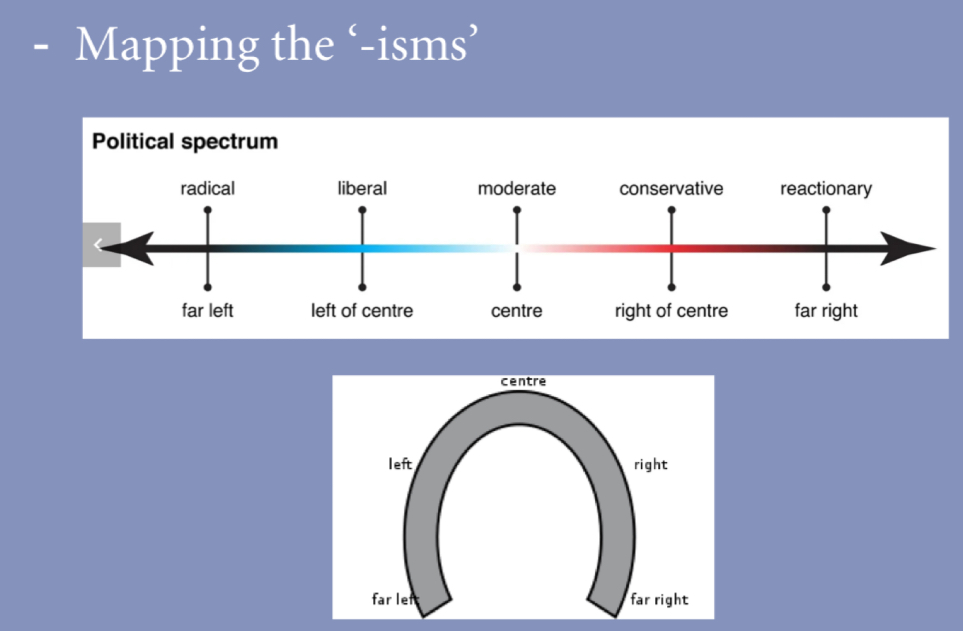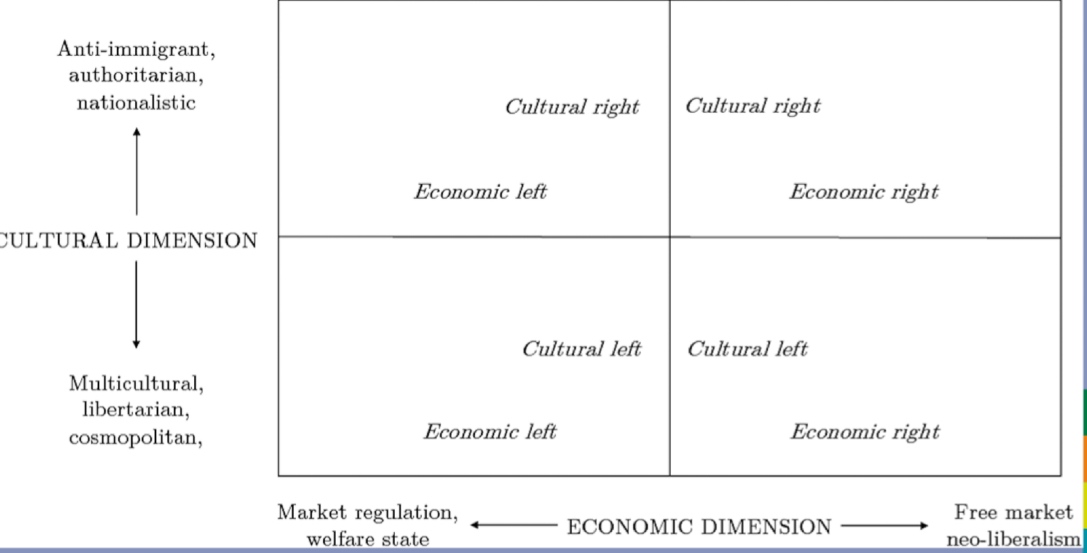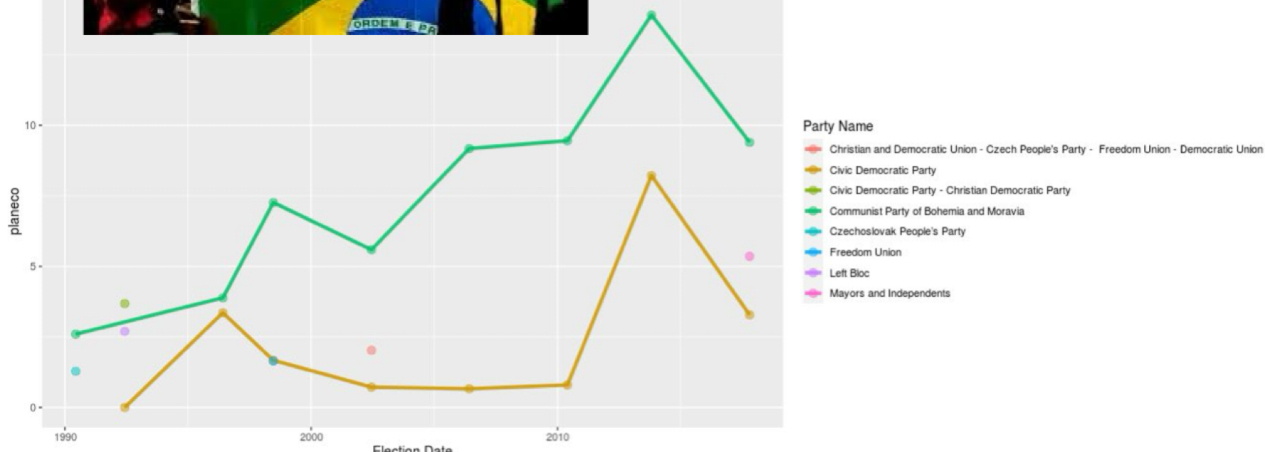Cleavages, Ideologies & Political Parties
1/30
There's no tags or description
Looks like no tags are added yet.
Name | Mastery | Learn | Test | Matching | Spaced |
|---|
No study sessions yet.
31 Terms
What are cleavages?
Certain division in society - different interests —> creating a collective identity among those on each side of the divide
Age
Gender
Religion
Ideology
Language
Geography
Many cleavages are not strongly politicized, meaning they remain dormant
Age
Gender
Main questions for political scientists: which cleavages become politically salient?
Political parties "establish regular channels for the expression of conflicting interests in democratic nation-states"
In authoritarian (and some hybrid) regimes cleavages may be present but cannot be a source of political competition; they are suppressed
Political cleavages
Lipset & Rokkan
Owner/worker
Church/state
Urban/rural
Center/periphery
Emerging the most strongly in the most recent decades
overlapping vs cross-cutting cleavages
Overlapping: most risky, lead to instability, violent conflict
Ex. Northern Ireland: center/periphery + Protestants/catholics
Cross-cutting: different interest groups —> can align
Multiple aspects of you so you can decide on what is most important in the moment to align with someone you might not agree with everything on
Ex. Belgium: Dutch speaking north vs French speaking south —> can align on certain issues (economic)
Europe - two revolutions
Importance (and sequence) of cleavage differed per country
Lead to different cleavages being politicized
French (national) revolution
Center/periphery
Church/state
Industrial Revolution
Owner/worker → Class
Urban/rural
Silent revolution —> material to post-material
Center/periphery cleavage
Originated in France/National revolution
Reaction to political centralization
Conflict between more powerful center and weaker periphery
Conflict about autonomy; cultural rights and privileges
Outcomes:
Secession (Eritrea, Ireland, Pakistan)
Substrate autonomy/federalism (Belgium, India, Nigeria)
Effective absorption into unitary state (France, Italy)
Persistent tension (Indonesia, Spain, UK)
Creates regional / secessionist parties
Religious cleavage
Originated in French Revolution
Originally: conflict between new elites (secular) and the clergy
But also refers to conflict between religious denominations (Catholic/Protestant, Hindu/Muslim)
Conflict centers on religious rights and role of religion in the public life
Education
Created confessional/conservative vs liberal parties
Class cleavage
Origin in Industrial revolution
Owners of capital and established elites vs working class
Conflict about economic conditions, political rights and redistribution
Present in virtually all democracies
Strength depends on perceived opportunities of mobility
Ex USA
Created socialist/social democratic/communist parties
Rural/urban cleavage
Landed aristocracy vs new industrialists
Old money vs new money
Positions in the state and power
Mostly resolved through social mobility for new industrialists
Less elitist cleavage still present Nordic countries: economic differences
Revival as reaction to green movement?
Cleavages and ideologies
Party formation around dominant cleavages, supported by ideology: how to tackle cleavages?
Can be invoked to mobilize people around cleavages
Common heuristic: left and right
Cultural left and right
Shifting meaning:
Republican (left) vs. monarchist (right)
Progressive (left) vs. conservative (right)
Secular (left) vs. confessional (right)
State-led economy (left) vs. free market laissez faire (right)
Ideology
collection of beliefs and values
Measuring ideologies

Freezing hypothesis
Lipset & Rokkan: Same parties and programmes around for a long time. The 1960s resembles the 1920s: Why?
Strenghtening party alignment (e.g. pillarization or 'Verzuiling)
Parties based on societal cleavages but also sustain these cleavages as 'political entrepreneurs'
Parties created different groups within their party for people to join to spread ideology and create people that are strongly associated with said party
Manipulation electoral rules (though mass suffrage eventually implemented)
Influence of electoral system
Affect the composition of the party system (Duverger's Law, 1954)
Majority / plurality systems tend to result in two-party competition
→ FPTP/SMD, two-round system, alternative voteProportional / mixed systems facilitate multi-party system
→ List PR, single transferable vote, mixed member proportionalMajority & plurality systems limit the number of cleavages that can be expressed in party competition
The ‘Silent Revolution’
1960s - 1970s
Inglehart: value change in postindustrial democracies
Shift from material to post-material values
Post-material values:
Democracy
Human rights (women,
LGBTQ+)Environment
Pacifism
Post-material values prominent among younger and wealthy voters
Postmaterialism and party system change: emergence of New
Left, Social Liberal and Green parties => political entrepreneurs!New parties in PR systems; incorporation of ideological elements into existing parties in majoritarian systems
A new transnational cleavage?
Hooghe & Marks (2018): response to immigration (and EU-integration)
The winners vs. the losers of globalization
Focus on:
immigration and multiculturalism
globalization and nationalism
culture and identity
majoritarian vs. liberal democracy
climate change (3) Covid-19 (3)
In some countries incorporated into existing party system (lUK, US)
In others; emergence of new parties (France, Italy) (partly due to slow responding mainstream parties)
New conceptualization left-right
Multiple dimensions of left and right
Not just economical but cultural

Transformation of cleavages
Lipset and Rokkan: the "freezing hypothesis"
Alignment: party identification on the basis of cleavage structures & ideologies
Recent decades
Realignment: shifting party identification on the basis of changing cleavages, resulting in (dramatic) changes in party system
Dealignment: declining party identification that is not replaced with a new one
Concern of today
Realignment
electoral volatility
Party vote changes from one election to the next
Dealignment
decreasing turnout
Not enough change for voters
Generational change?
Cleavages in New democracies
Cleavages can explain party systems in New Democracies, but different cleavages
Explanations:
No large-scale internal processes of state formation
No contestation for suffrage rights (exception: South Africa)
Greater role for individual politicians due to the absence of strong social organizations
Results:
High electoral volatility
Personalistic politics
Ethnic parties
Valence programmes & clientelistic politics
Ideology not necessarily absent
Former communist states are still going to have communist ideology to some degree
Dots on the graph show parties that were not around for a very long time —> electoral volatility

The ethnic party cleavage
Associated strongly with African parties
But similarities centre-periphery cleavage (cfr. Ireland,
BelgiumRoots of political saliency ethnicity?
Most common cleavage in new democracies —> identity/ethnic
Colonial and post-colonial dynamics
Lack of nation-building?
Or anti-nation-building?
Colonial ruler clumped together ethnic groups into one state —> no nation building
Also active policy against nation building
Heightening ethnic divides
Belgian colonial rule in Rwanda & Burundi (Urundi)
Tutsi minority, but
'tall, majestic, natural rulers'
Hutu majority, but
'short, stubby, smiling fools'
Ethnic identity cards policy
Certain regions of Africa were more economically interesting to colonizers —> Europe developing these areas more so their trade would go more smoothly
Created cleavages from the moment of independence due to some groups being richer bc of the development made by the colonizers
Belgium treated the different ethnic groups differently creating cleavages
Actively pitting people against each other
Prevention cross-cutting cleavages
Only cultural associations allowed under colonial rule => narrow bases early political mobilization
Colonizers would prevent any sort of political association —> would only be allowed to practice culture
This led to them only being able to relate to their own ethnic groups limiting any way of cross-cutting cleavages
Leaders of Congo: 250 political parties (ethnic groups)
Ghana: already had elections and parties
Able to create larger, non-ethnic parties
Authoritarian rule and third wave
Leaders claimed to fight for 'nationalism' but held on to power and often advantaged own group
Stewart (2002) 'Horizontal Inequalities: A Neglected Dimension of Development'
Inequality based on cultural group status (political, socio-economic, cultural)
Different from vertical inequality like Gini
Third wave of democratization
Return of multiparty democracy in the 1990s: return ethnic voting, though variation
Multi-ethnic/ethnic Congress parties
Not always clear majority ethnic group
Need to establish coalitions, not based on programmes but based on sharing state resources
Coalitions built but made up clientelism and corruption
Campaigns based on valence issues (development, better roads, anti-corruption, employment), but mostly identity, personality, and clientelism
Clientelism
Clientelism: reciprocal relation between patron (politician) and client (voter)
Client offers patron political support in exchange for material benefits
Jobs (patronage)
Food
Money (vote-buying)
Permits, loans
Often juxtaposed to programmatic politics (but..)
Clientelism and democracy
Negative connotations
Exclusive nature (ethnic bias)
Use of state resources to retain incumbency
But also: competitive clientelism
The competitiveness lead to more welfare and money for the people during the election period
Can be used in a democratic system
Example of Ghana:
Competitive
Turnover
Stability
Authoritarian regime: cleavages and conflict
Societal cleavages not channelled through multiparty competition
Alternative dynamics:
Violent conflict
Mass protests
Questions on (and predictions of?) political instability and regime change